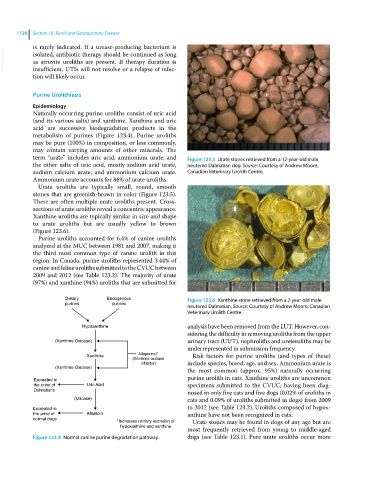Page 1190 - Clinical Small Animal Internal Medicine
P. 1190
1128 Section 10 Renal and Genitourinary Disease
is rarely indicated. If a urease‐producing bacterium is
VetBooks.ir isolated, antibiotic therapy should be continued as long
as struvite uroliths are present. If therapy duration is
insufficient, UTIs will not resolve or a relapse of infec
tion will likely occur.
Purine Urolithiasis
Epidemiology
Naturally occurring purine uroliths consist of uric acid
(and its various salts) and xanthine. Xanthine and uric
acid are successive biodegradation products in the
metabolism of purines (Figure 123.4). Purine uroliths
may be pure (100%) in composition, or less commonly,
may contain varying amounts of other minerals. The
term “urate” includes uric acid, ammonium urate, and Figure 123.5 Urate stones retrieved from a 12‐year‐old male
the other salts of uric acid, mostly sodium acid urate, neutered Dalmatian dog. Source: Courtesy of Andrew Moore,
sodium calcium urate, and ammonium calcium urate. Canadian Veterinary Urolith Centre.
Ammonium urate accounts for 86% of urate uroliths.
Urate uroliths are typically small, round, smooth
stones that are greenish‐brown in color (Figure 123.5).
There are often multiple urate uroliths present. Cross‐
sections of urate uroliths reveal a concentric appearance.
Xanthine uroliths are typically similar in size and shape
to urate uroliths but are usually yellow to brown
(Figure 123.6).
Purine uroliths accounted for 6.4% of canine uroliths
analyzed at the MUC between 1981 and 2007, making it
the third most common type of canine urolith in this
region. In Canada, purine uroliths represented 3.44% of
canine and feline uroliths submitted to the CVUC between
2009 and 2012 (see Table 123.2). The majority of urate
(97%) and xanthine (94%) uroliths that are submitted for
Dietary Endogenous Figure 123.6 Xanthine stone retrieved from a 2‐year‐old male
purines purines neutered Dalmatian. Source: Courtesy of Andrew Moore, Canadian
Veterinary Urolith Centre.
Hypoxanthine analysis have been removed from the LUT. However, con
sidering the difficulty in removing uroliths from the upper
(Xanthine Oxidase) urinary tract (UUT), nephroliths and ureteroliths may be
underrepresented in submission frequency.
Xanthine Allopurinol* Risk factors for purine uroliths (and types of these)
(Xanthine oxidase
inhibitor) include species, breed, age, and sex. Ammonium urate is
(Xanthine Oxidase)
the most common (approx. 95%) naturally occurring
Excreated in purine urolith in cats. Xanthine uroliths are uncommon
the urine of Uric Acid specimens submitted to the CVUC, having been diag
Dalmatians
nosed in only five cats and five dogs (0.02% of uroliths in
(Uricase) cats and 0.09% of uroliths submitted in dogs) from 2009
Excreated in to 2012 (see Table 123.2). Uroliths composed of hypox
the urine of Allantoin anthine have not been recognized in cats.
normal dogs
*Increases urinary excretion of Urate stones may be found in dogs of any age but are
hypoxanthine and xanthine
most frequently retrieved from young to middle‐aged
Figure 123.4 Normal canine purine degradation pathway. dogs (see Table 123.1). Pure urate uroliths occur more

